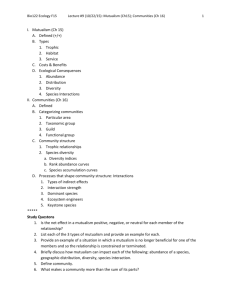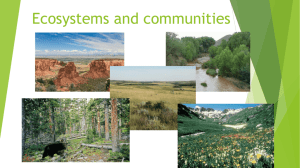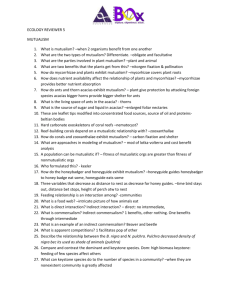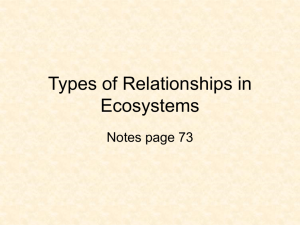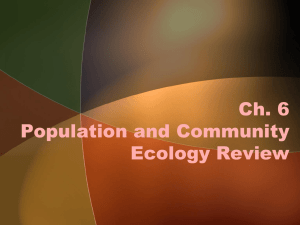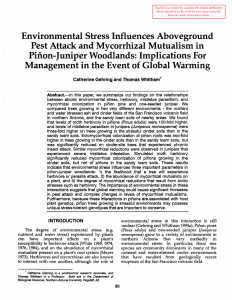Species interactions
advertisement
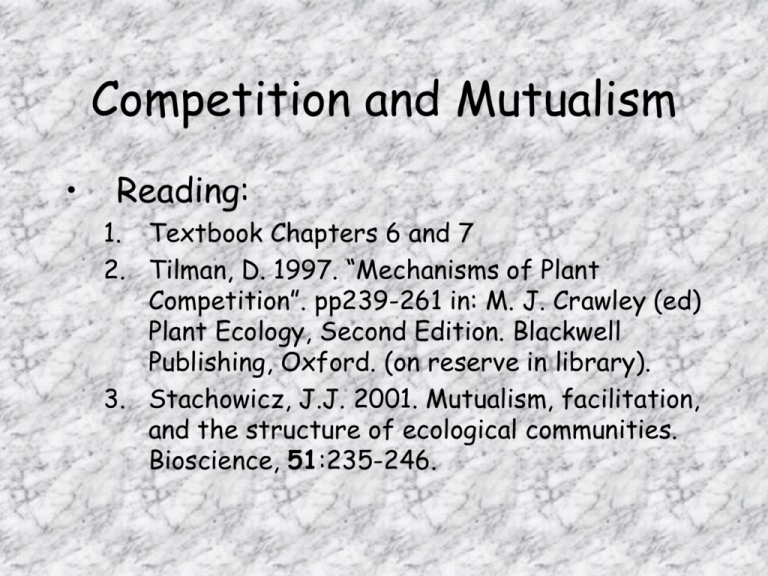
Competition and Mutualism • Reading: 1. Textbook Chapters 6 and 7 2. Tilman, D. 1997. “Mechanisms of Plant Competition”. pp239-261 in: M. J. Crawley (ed) Plant Ecology, Second Edition. Blackwell Publishing, Oxford. (on reserve in library). 3. Stachowicz, J.J. 2001. Mutualism, facilitation, and the structure of ecological communities. Bioscience, 51:235-246. Lab Feb 24 • Papers for discussion: – – Bais HP, Vepachedu R, Gilroy S, Callaway RM, Vivanco JM . 2003. Allelopathy and exotic plant invasion: From molecules and genes to species interactions. Science 301 (5638): 1377-1380 TBA (Herbivory? Or choose your favorite interaction) Seminars • EECB Colloquium: Thurs Feb 19. John Maron, University of Montana. “Rapid evolution in invading plant populations. Evidence from Hypericum perforatum” Outline 1. 2. 3. 4. 5. 6. 7. Types of species interactions Competition Mechanisms of competition Coexistence Mutualism Types of relationships Example: mycorrhizae Interactions organized in following way: + - 0 + - 0 Mutualism Predation Parasitism herbivory Competition Commensalism Predation Parasitism herbivory Commensalism Amensalism Amensalism Neutralism Competition • • • Ability of one species to inhibit the survival and/or growth of individuals of another species = interspecific competition. Ability of individuals to suppress growth or survival of conspecifics = intraspecific competition (density dependence, e.g.) Effects can be substantial: e.g. 16-fold decrease in growth of little bluestem in presence of neighbors (Wilson and Tilman 1991). Competition Models • • • Consider joint carrying capacity of N1 + N2 Species 2 has an effect α on species 1. Species 1 has an effect β on species 2. Alter logistic growth equations as follows: Species 1: dN1/dt=r1N1((K1-N1-αN2)/K1) Species 2: dN2/dt=r2N2((K2-N2- βN1)/K2) Effect and Response • Competitive effect: ability of plant to suppress other species. Competitive response: ability of plant to persist in presence of competitors (i.e. resist suppression). • • – How do they differ? How would they affect alpha and beta? Handout: tree tolerances. Does this describe competitive effect or competitive response, or both? Competition Mechanisms • • • • Species vary in the nutrient concentrations they require for positive net growth Resources are limited Changes in plant density/biomass alter resource availability (rate of consumption) This influences and survival and growth Equilibrium concentration R* • • • R* is resource concentration at which a species “breaks even”. Differs among species. R* depends on species growth rate and change in growth rate with change in resources. All things equal, a species will reduce a resource to its R*. Equilibrium concentration R* • • With one limiting resource, species with lowest R* will “win”. For soil resources (e.g. N): negative correlation between R* and root mass (e.g. tallgrass prairie, Tilman and Wedin 1991) ZNGIs • • Zero net growth isoclines: graphical representation of resource use and competition Show that at equilibrium coexistence is possible if each species limited by a different resource Coexistence • Why are communities diverse? Coexistence • If tilmans models are right, only as many species as there are different limiting resources should coexist. Why are communities diverse? Coexistence 1. Neighborhood effect: deplete resources in spatially discreet area; low R* in plant’s immediate vicinity. 2. Spatial heterogeneity: resource supply variable at very small scale. 3. Resource fluctuations in time: “storage effect” 4. Non-equilibrium conditions: disturbance, herbivory, etc. Coexistence • If tilmans models are right, only as many species as there are different limiting resources should coexist. Why are communities diverse? Apparent competition • • More complex 3rd order interactions create appearance of competitive effects: Example: Species 1 is primary food source for herbivore; Species 2 is secondary. Presence of Species 1 can suppress species 2 via shared herbivore. Competition in range and forest ecosystems • What is the importance of competition? Mutualism • • • Mutually beneficial interactions. More widespread and important than often given credit for; much less studied than competition. Very important in range and forest ecosystems. Examples? Mutualism • Four main types: 1. Nutritional: breakdown and supply of nutrients (e.g. mycorrhizae to plant) 2. Protection: from extreme site conditions or predators/pathogens (e.g. fungus to alga, nurse plants) 3. Transport: dispersal of seed, pollen, etc. (e.g. fruit bats to banana trees, bees to orchids) 4. Energy: supply of photosynthetic energy by plants to associates (e.g. plant to mycorrhizae; alga to fungus) Mutualism models • • Mathematical models not as well developed as for competition or predation but… Can convert “Lotka-Volterra” competition models into mutualism models (+ effect). Species 1: dN1/dt=r1N1((K1-N1+αN2)/K1) Species 2: dN2/dt=r2N2((K2-N2+βN1)/K2) Mutualism models • • • But: this causes positive feedback and rapid exponential growth. “Orgy of mutual benefaction” (May 1973) Better models: economic models and game theory. Cooperation is mutually beneficial. But: cheaters may prosper. Must be mechanisms for “policing” : e.g. Yucca moths. Cheaters oviposit but don’t pollinate. Solution? Yucca selectively aborts flowers with many moth larvae (Pellmyr and Huth 1994. Nature 372:257-260) Example: mycorrhizal associations • Ectomycorrhizae – form extensive hyphal mats that grow between but not within cells. Usually Basidiomycotes and Ascomycotes. Common on woody forest species (e.g. pines, fir, hemlock). Modify external appearance of root. Example: mycorrhizal associations • • Ectomycorrhizae – form extensive hyphal mats that grow between but not within cells. Usually Basidiomycotes and Ascomycotes. Common on woody forest species (e.g. pines, fir, hemlock). Modify external appearance of root. Endomycorrhizae – hyphae penetrate root cells. Visible only by microscope. VAM= vesicular arbuscular mycorrhizae (named for structures in root cells). Benefits and extent • • • • • Fungus receives carbohydrate from plant Plant receives increased “root area” with substantial gains in water and nutrient gathering capacity (P, N). Most plants form some sort of mycorrhizal association. Trees have ecto, sometimes VAM or both. Most range plants have VAM. Most common and important in low-resource areas. Colonization may be decreased in high nutrient or disturbed areas. Can be affected by herbivory. Importance • May affect competitive interactions and invasion success. – – Maintenance of dense grassland Some invasions might fail because of lack of symbionts Importance • • May affect competitive interactions and invasion success. Often necessary for tree growth: example – failed afforestation attempts in areas of grassland Importance: example • White Fir in Klamath mountains… – Clearcut caused shift in soil microbial community (fungal to bacterial) – Some clearcuts cannot be re-vegetated despite numerous attempts since 1960 – Planting seedlings along with soil from healthy forest increased survival 50% in first year. – After 3 years, 100% mortality without inoculum. – In some cases, tree growth stopped at edge of inoculated hole.
